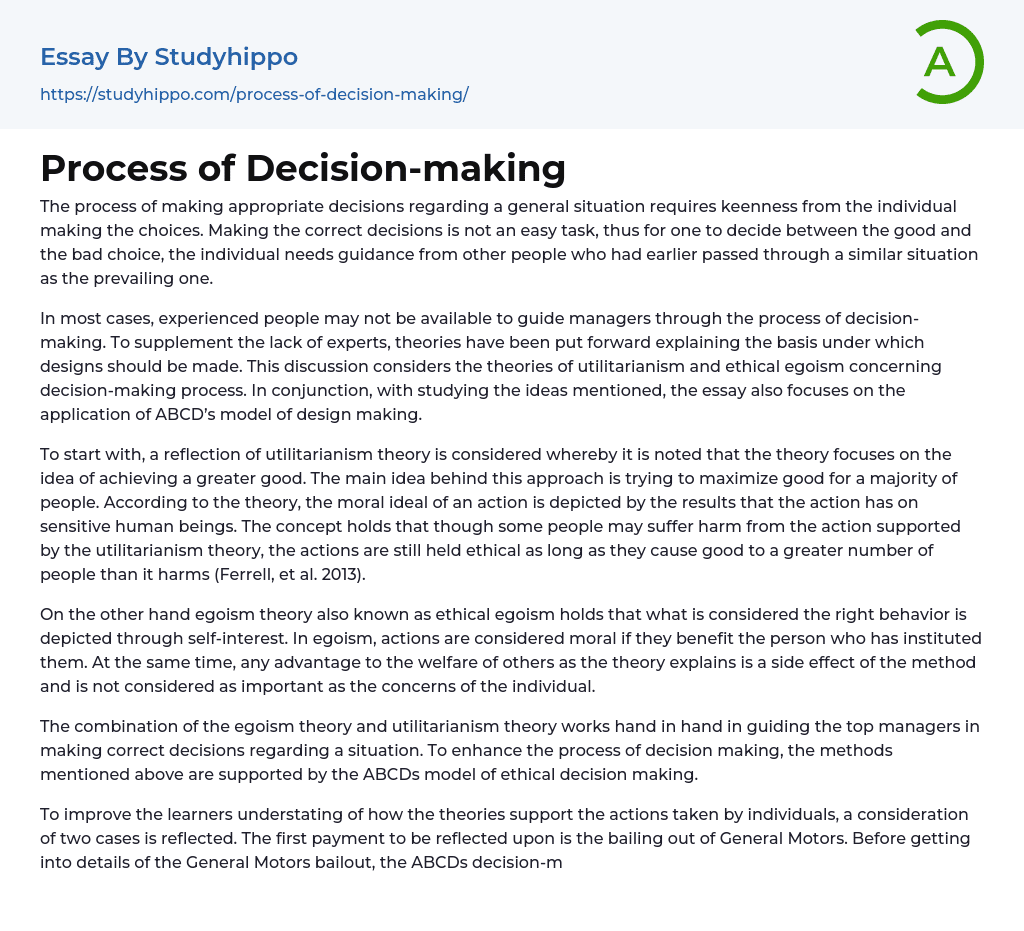When individuals are confronted with decisions in a general situation, they must carefully consider their options. It can be difficult to make the correct choices, and at times it is necessary to seek guidance from others who have faced similar situations. Unfortunately, managers may not always have access to experienced individuals who can assist them in these circumstances. To tackle this problem, decision-making theories like utilitarianism and ethical egoism have emerged as helpful guides.
The essay delves into the examination of concepts and the execution of ABCD's design making model. It initiates by evaluating utilitarianism theory, which strives to accomplish a higher good and optimize general well-being for the majority. This theory asserts that the ethical worth of an action is ascertained by its impact on susceptible individuals.
Utilitarianism and ethical egoism are two philosophical concepts that determine the
...morality of actions. Utilitarianism focuses on maximizing overall good, even if it means some individuals suffer. According to this concept, as long as an action brings greater benefit than harm to a larger number of people, it is considered ethical (Ferrell, et al. 2013). On the other hand, ethical egoism, also known as egoism theory, argues that right behavior is determined by self-interest. From this perspective, actions are morally acceptable if they benefit the individual who performs them.
The theory suggests that benefits to others are secondary to individual concerns. Top managers use both egoism theory and utilitarianism theory in decision making. The ABCDs model of ethical decision making supports these methods. Two cases, including the rescue of General Motors, help understand how these theories influence individuals' actions.
The ABCDs decision-making model offers a set of guidelines for making decisions
Each letter in the model corresponds to a specific action that should be taken. The initial step involves assessing the situation, followed by brainstorming ideas, contemplating the potential consequences, reaching a decision, and finally evaluating the outcome.
The United States government rescued General Motors from bankruptcy after a faulty car model caused significant damage. The ethicality of this action can be evaluated using theories and quantifiable measures (MacKinnon, 2014). To scrutinize the government's decision, utilitarian calculations are used to determine if saving General Motors was justified. These calculations consider the decisions made and assess the impact on primary and secondary stakeholders. The bailout had both negative consequences and advantages for stakeholders since it involved taxpayer funds.
According to the theories of utilitarianism and egoism, which aim to maximize good and individuals' happiness respectively, the acceptance of the bailout is justified. In order to validate the government's decision, it is important to consider the advantages that come with the rescue. Firstly, the bailout has benefited both the company and its employees. It has allowed the company to continue its operations and avoid bankruptcy. Although the rescue has damaged the company's reputation, causing harm, the advantages of the bailout outweigh the negative effects.
Without the bailout, General Motor Company could have shut down, exacerbating the situation. Hence, the positive impact of bailing out is acknowledged as it aligns with utilitarianism. Despite utilizing taxpayer money for the bailout, it averted the company's collapse and safeguarded employment for citizens (MacKinnon, 2014). Moreover, taxpayers experienced advantages from a conducive business environment that ultimately resulted in substantial economic growth.
The employers benefited from the bailout by reducing employee layoffs. To ensure an informed decision, CEOs
need an ethical framework that promotes a systematic evaluation of proposed actions and their impact on stakeholders. Ethical behavior involves considering the perspectives of all affected individuals before taking action. The CEO of General Motors carefully addressed the company's crisis and used the ABCDs ethical model to make the right decision. This model engages in relevant activities for each specific situation, although it takes time, it leads to the most appropriate course of action.
Both egoism and utilitarianism are frequently employed in decision-making as they consider the consequences of individual actions. Humans naturally think about the outcomes before acting, often leading them to avoid potentially beneficial actions. The theories addressed in this essay rationalize the impacts of people's actions. Nevertheless, their limitations occasionally require integrating these theories with other normative frameworks like the ABCDs ethical decision model.
- Incentive essays
- Board Of Directors essays
- Brand Management essays
- Business Ethics essays
- Business Management essays
- Change Management essays
- Comparative Analysis essays
- Decision Making essays
- Dispute Resolution essays
- Knowledge Management essays
- Leadership essays
- Leadership and Management essays
- Manager essays
- Operations Management essays
- Performance Management essays
- Product Management essays
- Project Management essays
- Quality Management essays
- Risk essays
- Risk Management essays
- Scientific Management essays
- Stress Management essays
- supply chain management essays
- Time Management essays
- Total Quality Management essays




